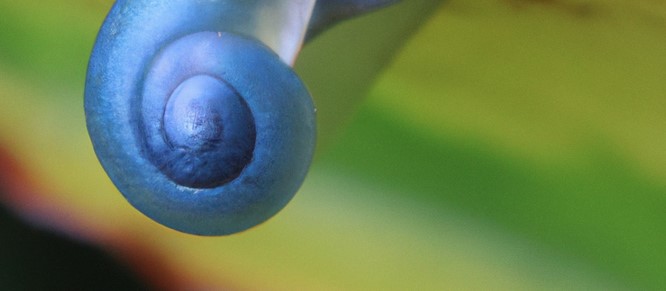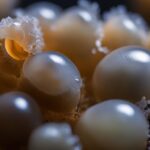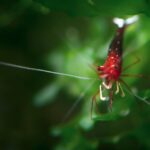The Aquarium’s Unassuming Janitor: An Overview of Snails in Fish Tanks
The aquarium is a delicate ecosystem, each inhabitant playing its crucial role. Among the colorful fish and swaying aquatic plants, a tiny life form often goes unnoticed: the humble snail.
These slow-moving creatures can be found navigating through the gravel, scaling glass walls, and happily munching on plants or algae. Snails are common inhabitants of both freshwater and saltwater tanks.
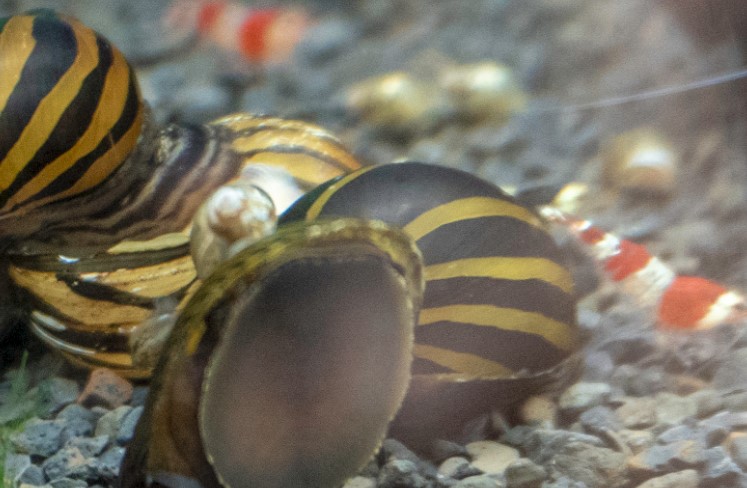
At first glance, they may just seem like an optional addition to your aquarium. Yet these unassuming gastropods play an invaluable role in maintaining tank health by consuming excess food and algae – effectively acting as a natural cleaning crew.
However, their beneficial role doesn’t end with cleaning. Snails also contribute to nutrient cycling within the tank by feeding on decaying organic matter and excreting waste that subsequently provides nutrients for plant life.
Despite their often-overlooked benefits, many individuals question if they are indeed good for fish tanks. Therein lies a debate as old as aquaristics itself: Are snails beneficial companions or troublesome pests?
The Great Gastropod Debate: Are Snails Good or Bad for Fish Tanks?
To fully appreciate this debate’s complexity, one must understand that not all snails are created equal; different species offer varying benefits while posing unique challenges. Some types of snails consume harmful algae at impressive rates while others may voraciously devour aquarium plants instead – a habit unwelcome by most aquarists. Given these variances among species coupled with individual experiences, it’s no surprise that opinions diverge widely when discussing whether snails’ benefits outweigh their potential drawbacks.
On one side of the argument stand those who champion the utility of snails in fish tanks – citing their roles as cleaners, nutrient cyclers, and interesting additions to the aquatic community. These individuals appreciate snails’ hard work in controlling algae growth and maintaining a healthier ecosystem overall.

However, on the other side of the debate are those who view snails as pests. These individuals point to snails’ potential for rapid reproduction and their tendency to consume aquarium plants as major drawbacks.
In extreme cases, unchecked snail populations can create an imbalance within the tank’s ecosystem. Are snails good or bad for fish tanks?
The answer lies not in stark black-and-white terms but rather in understanding the nuances of your specific aquarium environment. By considering factors such as your tank’s size, its inhabitants, and your own preferences as an aquarist, you can decide which – if any – species of snail would be beneficial additions to your underwater world.
Understanding Snails: Anatomy, Types, and Natural Habitat
The Intricacies of Snail Anatomy
The anatomy of a snail is an amalgamation of complex systems that contribute significantly to their role in any fish tank. A snail comprises primarily a shell, muscular foot, tentacles and radula. The most salient feature, the coiled shell, serves as a protective sanctuary against potential predators and harsh tank conditions.
This calcareous structure grows with the snail and its color can provide interesting visual diversity among aquarium inhabitants. Snails are gastropods which means ‘stomach foot’.
This nomenclature refers to their unique muscular foot used for locomotion along the substrate or glass walls of the tank. As they move, they secrete mucus that aids in food intake and provides a medium for beneficial bacteria to flourish.
Situated on their cephalic region are tentacles which assist in navigation and food detection. Some species have eyes located at the base or tip of these tentacles enhancing their sensory capabilities within the aquarium environment.
Is the radula; this tongue-like organ covered with thousands of microscopic teeth scrapes algae off surfaces which makes snails efficient custodians of fish tanks. In essence, every facet of snail anatomy plays an integral role in maintaining equilibrium within fish tanks – from fostering bacterial growth for water filtration to preventing algal outbursts by grazing on surplus nutrients.
An Overview Of Snails Typically Found In Fish Tanks
Taking up residence in various corners around our aquatic habitats are diverse types of snails that bring distinct characteristics into play. Most commonly encountered are Mystery Snails, Nerite Snails, Trumpet Snails and Ramshorn Snails.
Mystery Snails
Known for their vibrant shells ranging from ivory to deep blue, Mystery Snails add captivating shades to your aquarium. They are largely peaceful creatures that tend to thrive in well-established tanks with plenty of plant matter and biofilm for consumption.
Nerite Snails
Nerite Snails, with their distinctive patterns and voracious algae-eating habits, are a favorite among many aquarists. Outfitted with powerful radulae, they have the ability to cleanse tanks of unwelcome algae infestations.
Trumpet Snails
The Trumpet Snail’s greatest asset lies beneath the surface—literally. With their burrowing tendencies, they help in aerating the substrate and thereby promote root health and nutrient cycling.
Ramshorn Snails
Named after the ram’s horn due to their uniquely coiled shell, Ramshorn snails contribute to tank hygiene by feeding on leftover fish food and decaying plant material which prevents toxic ammonia build-up.
The Natural Habitat of Aquarium Snails And Their Adaptability
The natural habitats of these snail varieties differ greatly but all share a common trait – adaptability. From freshwater rivers and streams to coastal marine environments, these snails exhibit remarkable resilience against changing conditions making them suitable for contained aquatic ecosystems like aquariums.
Mystery and Ramshorn snails primarily originate from slow-moving freshwater bodies rich in vegetation while Nerite snails are predominantly found in brackish waters along coastlines. Trumpet snails inhabit both slow-moving freshwaters as well as high nutrient load environments akin to fish tanks.

In captivity, these creatures display tremendous adaptability as they can tolerate a range of water parameters provided that changes occur gradually. That said, each species has its specific requirements and preferences that must be considered to ensure their survival and aid in maintaining a thriving fish tank.
Understanding the biology of these unassuming gastropods along with their natural habitats can greatly assist aquarists to make informed decisions about introducing snails into their aquariums. Not only do these creatures enhance the visual appeal of the tank, but they also play an integral part in maintaining its health and balance.
The Good: Benefits of Having Snails in Fish Tanks
Unsung Heroes: Snails as Natural Cleaners
Snails are veritable janitors of the fish tank world, providing invaluable cleaning services that can keep your aquarium pristine. First and foremost, they consume algae, an inevitable blemish in any freshwater tank.
Their incessant grazing keeps the aquarium walls and decorations remarkably free from unsightly and unhealthy algal bloom. The second significant contribution snails make as cleaners is through their consumption of detritus.
This miscellaneous debris in a fish tank includes dead plant material, uneaten food, and even fish waste. Snails are indiscriminate eaters, helping to minimize this organic matter that could otherwise foul the water quality.
With their unique digestive system, these mollusks break down complex organic materials into simpler substances. In doing so, they naturally detoxify the aquatic environment while reducing the frequency and intensity of maintenance tasks such as water changes or substrate vacuuming.
Moreover, by consuming excess food before it decomposes entirely and releases harmful chemicals into the water column, snails inadvertently help balance pH levels. This action contributes significantly to maintaining optimum water conditions for fish health.
Cogs in Nature’s Wheel: Contribution to Ecosystem Health
In addition to tidying duties, snails contribute significantly to ecosystem health through nutrient cycling and soil aeration in planted tanks. They fulfill an essential role in nutrient cycling by consuming organic waste materials; they digest these substances converting them into usable nutrients released back into the system via their excretions. This process helps promote plant growth within your aquarium as plants absorb these nutrients directly from the surrounding waters or substrates.
The positive impact on plant life further enhances overall ecosystem health by improving oxygenation levels for other inhabitants like fish or shrimp. Aquarium snails also work similarly to earthworms in a garden, mixing and aerating the substrate as they burrow.
This action helps prevent anaerobic spots that can create pockets of harmful gasses. This process also aids in ensuring an even distribution of nutrients within the substrate, a critical factor for well-nourished root systems of aquatic plants.
Living Art: The Aesthetic Appeal of Snails
Beyond these practical roles, snails bring a unique aesthetic appeal to your fish tank. They introduce diversity in shape and form to an aquarium otherwise dominated by fish.
The movement patterns and slow pace of snails provide a contrasting visual spectacle that can be hypnotically calming. Snails come in an array of types, each with distinct coloring and shell patterns.
From the elegant spiral shell of the Ramshorn snail to the striking striped pattern on Nerite snails, these mollusks add visual variety to your tank. Their colors range from golden hues to earthy browns or even intense blues, depending on the species.
Furthermore, observing snails going about their daily tasks and interactions can be every bit as enticing as watching fish swim about. They add another layer of complexity and interest to an aquarium setup; their distinctive behaviors may captivate aquarists who enjoy understanding and observing diverse life forms within their personal underwater worlds.
Snails may not be traditional choices for aquarium centerpieces or showstoppers like vibrant fish species tend to be. However, their quiet charm lies in this very subtlety – they are unassuming in appearance yet undeniably essential actors contributing significantly to both aesthetic appeal and ecosystem health within a thriving fish tank.
The Bad: Drawbacks of Having Snails in Fish Tanks
An Overzealous Appetite: Snails and Impact on Aquatic Plant Life
In the counter narrative to their praiseworthy contributions, snails may also pose certain challenges within the confines of an aquarium. Foremost among these issues is their potential for overgrazing. While it is true that snails are nature’s gentle gardeners, diligently consuming dying leaves and algae, there are instances when they extend their diet to healthy plants as well.
This can especially be the case with some species like the infamous Apple Snail which can rapidly decimate aquatic vegetation if left unchecked. To make matters more precarious, this overgrazing isn’t always immediately noticeable.

It begins subtly, with small nibbles on plant leaves which slowly but surely escalate into full-blown defoliation over time. This poses a significant risk not just to individual plants but also disrupts the overall aesthetic beauty of your aquarium – a key reason many aquarists engage in this hobby.
Additionally, it’s worth noting that certain plants are more susceptible than others to snail damage. Delicate species with thin leaves often fall victim quickly while tougher varieties like Java Fern are usually ignored by snails.
Hence, introduction of snails should ideally be accompanied by a careful review and possible reconfiguration of your choice in flora. While it’s true that not all aquarium snails will not munch on healthy plants excessively, identifying those who do can prove challenging given their nocturnal lifestyle which often keeps their misdemeanors out of sight.
Unruly Multiplication: The Challenge of Snail Population Control
Another significant drawback associated with keeping snails in fish tanks is controlling population growth – a challenge even for experienced aquarists. These creatures reproduce quite prolifically under conducive conditions (which most home aquariums provide), leading to a population explosion. The root of this issue lies in the snail’s reproductive strategy.
Many freshwater snails are hermaphrodites meaning they have both male and female reproductive organs, thus, every individual has the potential to lay eggs. When coupled with a plentiful food supply (as is often the case in well-fed aquariums), these molluscs can churn out several generations within a very short span of time.
This rampant reproduction is not just an aesthetic problem – turning your carefully curated underwater world into a teeming mass of snails – but also creates practical issues. Overpopulation can lead to increased competition for food and resources, putting stress on all tank inhabitants.
Moreover, excess waste produced by large snail colonies can affect water parameters and quality drastically, ultimately risking the health of your fish and other aquatic animals. Thus, maintaining an equilibrium becomes imperative when keeping these slow-moving creatures in your aquarium.
Unseen Foes: Snails as Carriers of Disease
Snails are not only detritivores but also opportunistic scavengers; this lifestyle unfortunately makes them potential carriers of various parasites and diseases that could pose significant threats to fish and other inhabitants within your aquarium ecosystem. One such fearsome parasite is the notorious Flukes (Trematodes) which use snails as intermediate hosts during their complex life cycle before moving onto fish or humans causing debilitating disease. Addition of infected snails into fish tanks can inadvertently introduce these parasites too – spelling serious trouble for unsuspecting aquarists.
Additionally, certain bacteria like Mycobacterium marinum that cause Fish Tuberculosis can be harbored by snails without showing any signs themselves but with fatal consequences for infected fish. Furthermore, shell rot – a common ailment among captive snails – if left untreated can give rise to secondary bacterial infections potentially affecting other tank mates as well.
The key here lies in early detection and treatment which admittedly can be challenging given the often subtle signs of snail diseases. Despite these challenges, understanding the potential risks and implementing regular health checks can significantly mitigate the risk posed by these issues and ensure a thriving, balanced aquarium ecosystem.
Case Studies: Real-life Experiences with Aquarium Snail Keeping
Triumph in the Tank: Positive Experiences of Snail Integration
Just as there are two sides to a coin, so are the experiences of aquarists when it comes to incorporating snails into aquarium ecosystems. There are numerous instances wherein snails have played an instrumental role in enhancing the quality and health of aquatic environments.
For instance, one aquarist from Florida recounts his experience with Mystery Snails. Initially introduced to combat a persistent algae problem, the snails not only cleaned up the tank but also added an unexpected aesthetic appeal with their gentle gliding movements and vibrant shells.
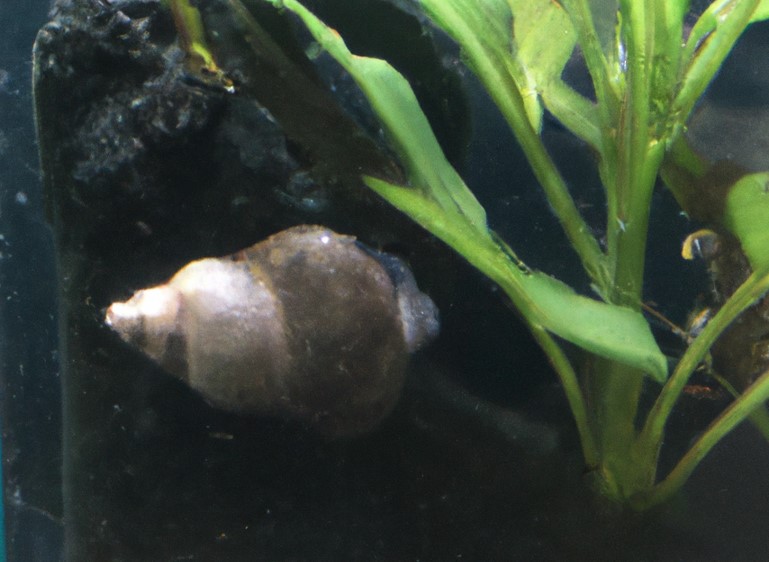
Another inspiring case is that of a fish hobbyist from Seattle whose tank was suffering from poor plant growth due to unfavorable soil conditions. Upon introducing Trumpet Snails, which are renowned for their burrowing habits and soil aeration capabilities, he noticed a significant improvement in plant health and vibrancy.
Over time, these snails effectively transformed his previously struggling fish tank into a thriving aquatic garden. A final account worth acknowledging is that of an aquarist from Toronto who had been battling an issue with detritus buildup in her freshwater aquarium.
After adding Ramshorn Snails (excellent detritivores) to her tank setup, she observed a notable decrease in waste materials littering the substrate and clouding the water column. These positive accounts illustrate how, when properly managed and understood, snails can enhance aquarium ecosystems in multiple ways- from promoting cleanliness to improving soil quality.
Aquatic Ailments: Negative Experiences Stemming From Uncontrolled Snail Populations
However, not all interactions between snail species and aquariums lead to such harmonious outcomes. Unmonitored or excessive populations can cause havoc within enclosed aquatic systems. In particular, one case involved an aquarist from Texas.
After introducing a seemingly harmless pair of Pond Snails as part of his aquatic setup, he soon witnessed an unrestrained population explosion. The dense snail populace rapidly consumed the aquarium’s plant life, leading to a starkly bare tank.
Similarly, an aquarist from New York reported significant challenges with Nerite Snails. Despite their renowned reputation for effective algae control, unchecked reproduction led to overpopulation and subsequent depletion of food sources.
This ultimately resulted in weakened snails and the transmission of diseases that affected other inhabitants in the tank. A California-based fish hobbyist experienced another problem intrinsic to overcrowded snail populations – they can become a reservoir for harmful parasites.
In his case, the Apple Snails he introduced carried and spread a parasite which caused havoc amongst the fish in his collection. An aquarist from Georgia narrates how her failure to monitor her Trumpet Snails led to them severely disturbing the substrate layers with their constant burrowing activity.
This inadvertent behavior disrupted rooted plants and caused unsettling fluctuations in water chemistry. These cautionary tales remind us that while snails can be beneficial aquarium residents when carefully managed, they can also pose threats if allowed to proliferate unchecked.
Managing the Balance: Choreographing the Coexistence
The Art of Feeding: Calibrating Consumption and Control
The critical first step to maintaining a healthy aquarium with snails lies in proper feeding practices. Overfeeding is a common mistake made by aquarists, leading to an excess of food and subsequently a surge in the snail population. A balanced diet aids in keeping their numbers manageable and preventing the undesired swift takeover of your tank.
Understanding the dietary needs of your fish and snails is paramount. Snails, being opportunistic feeders, will feast on any leftover fish food before it decays, thereby mitigating water pollution but also encouraging their reproduction.
Controlling your fishes’ feeding pattern with appropriately portioned meals administered at regular intervals minimizes leftovers, subsequently keeping snail populations in check. Implement more natural alternatives into their diet such as blanched vegetables or specialized snail pellets.
Such foods are not only healthier but also easier to monitor consumption levels. Remember that moderation is vital; too little can cause malnutrition while too much instigates an uncontrolled breeding spree.
Vigilance Unleashed: The Power of Regular Monitoring
A stitch in time saves nine holds true for managing aquariums with snails too. Regular monitoring allows timely detection of potential population explosions or health issues – both crucial mariners guiding you safely through your nautical endeavour. Observing changes within your tank’s ecosystem provides valuable insight into underlying problems that could escalate if left unattended—a sudden increase hint towards overfeeding or presence of decomposing organic matter stimulating reproduction.
Counting snails might seem a daunting task given their size, shell patterns blending effectively with surroundings. Still, it becomes relatively simple once you fathom their behavior pattern—snails are typically more active during dawn and dusk making this the ideal time for census-taking.
Natural Predators: Balancing the Scales of Life
Nature always has a way of maintaining balance and so does your aquarium, with the introduction of natural predators to control snail population. This method, while useful, should be used judiciously and carefully as it influences both the aquatic environment and the existing food chain. Predatory species commonly introduced include loaches, puffer fish and certain cichlids.
As these fish are known to feed on smaller snails, they naturally help in controlling their numbers. However, one must ensure compatibility with other tank inhabitants to prevent unnecessary distress or conflict.
While this might seem like fighting fire with fire, it is necessary to remember that these measures should be seen as a last resort when other methods have proven ineffective. After all, balance is not about elimination but about harmony amongst all living creatures within your captive ecosystem.
Conclusion
Navigating through the world of aquatics teems with challenges – striking a balance between maintaining an aesthetically pleasing environment whilst ensuring the welfare of its inhabitants lies at its heart. Snails in fish tanks are not inherently pernicious; rather their unchecked proliferation becomes problematic. Yet armed now with knowledge about proper feeding practices, regular monitoring techniques and natural predator introduction you set sail better equipped for your voyage into aquatic life stewardship.

